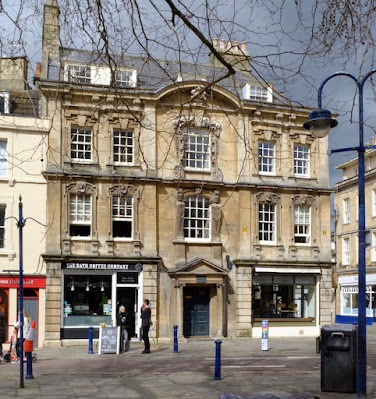Monday, May 10, 2021
Bath, Somerset
Matters of taste
Kingsmead Square seemed to be the perfect spot for a socially distanced cup of coffee on a recent visit to Bath. Our seat was also a good place from which to admire the entrance front of Rosewell House, named for the person who had it built, one Thomas Rosewell. Rosewell’s architect was Nathaniel Ireson of Wincanton who developed part of this square in the 1730s – there’s a carved datestone inscribed ‘1735’ at the very top of the house’s facade. By this time, John Wood Senior had already set the style for Georgian Bath with developments such as the grand, palace-fronted Queen’s Square. But Wood’s style was less reliant on ornament and more on proportions than this house. Ireson’s mode was more akin to the lively baroque of the beginning of the 18th century – so there’s plenty of carving, more curves, more elaboration.
You can see this wherever you look. The windows all have fancy surrounds – the first-floor ones with carved busts in the keystones, the big central windows even more elaborate, one with a surround of curves and scrolls, one flanked by upright figures. There are lots of pilasters dividing up the frontage and book-ending it, those on the ground floor with banded rustication. The whole is topped by a deep cornice and segmental pediment that contains the carved datestone, which is concealed behind a tree branch in my photograph. Presumably the ground floor would originally also have had sash windows, but the spaces now accommodate shop windows.
I find all this detail fascinating. It’s even more elaborate than the beautiful stone facades in a smaller Georgian town like Stamford in Lincolnshire, another place where the provincial taste for baroque elements lingered longer than they did in more ‘progressive’ and ‘sophisticated’ cities like Bath. John Wood, in the vanguard of sophistication, did not care for this sort of thing, which he referred to as ‘ornaments without taste’. Well, Wood built some fine houses, and I have some respect for him as an architect, but I’ll happily look at this example of what he saw as bad taste all day. There is more than one way to design a classical town house, and Bath has room for several different approaches.
Subscribe to:
Post Comments (Atom)




6 comments:
Interesting I just wrote about Georgian architecture this week :) So I am guessing that John Wood snr was better known and had a bigger influence than Thomas Rosewell's fancy surrounds. Georgian Bath has probably set the standard for centuries.
As always an interesting blog, on of those I recommand with a link from my own. May I ask what decides your selection of presentations - coincidence or a selection of what you recently have seen yourself? Anything previously from Bornemouth?
How good to read a mention, albeit brief, of the C18 work at my favourite small town, Stamford! So many turn up looking for a medieval town, which it is, and don't really notice all the later fine buildings. And somehow the C17 work gets ignored as of little interest. Thank you, as ever, for your insights into familiar styles and buildings.
Hels: Yes, Wood was much better known than Rosewell or his architect Ireson.
Monique: Thank you! My selections are normally places I've recently seen. During 2020 and 2021, travel has been hugely restricted in the UK, so I've been drawing from my picture archives of past visits, and choosing what I post to provide what I hope is interest and variety. It's a long time since I last went to Bournemouth (and have no photographs of my own from back then) but have done a few posts about nearby Poole, which you can find using the search box at the top of the blog.
Per Apse: Stamford is a marvellous place, I think. So much to see, especially in the shape of Georgian houses (and also medieval churches of course).
Post a Comment